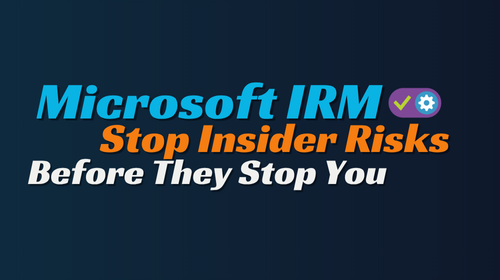- Home
- Security & Compliance
- Let’s Talk About Microsoft 365 Insider Risk Management 🕵️♂️
Let’s Talk About Microsoft 365 Insider Risk Management 🕵️♂️
Is Someone Inside Your Company a Threat? 
Let’s Talk About Microsoft 365 Insider Risk Management
Imagine this:
An employee quietly hands in their resignation. Suddenly, they start downloading company files 📁 and sending them to a personal email 📤.
No one notices — until a competitor launches a product just like yours or Someone Chasing/Contacting all your Customers..
Scary, right?
That’s why insider threats need more than antivirus and firewalls.
You need visibility, detection, and control from the inside.
That’s exactly what Microsoft 365 Insider Risk Management (IRM) offers.
💡 What is Insider Risk?
Insider risk is when someone inside your company like an employee, intern, vendor, or consultant does something that could harm your business.
This harm can be:
Accidental: Sending the wrong file to the wrong person
Careless: Copying sensitive data to a USB stick without thinking
Intentional: Taking company secrets to a new job with a competitor
These situations are hard to detect because the person is already trusted and has access to your data 🔐.
That’s where IRM helps, by watching for risky actions, not just outsiders.
🛡️ What Microsoft 365 Insider Risk Management Does
IRM helps your company detect and respond to risky behavior inside your business.
Here’s what it can catch:
📥 Mass downloads: Employees downloading large numbers of files at once
🔌Copying to USB: Saving files to external drives
☁️Cloud uploads: Moving files to Google Drive, Dropbox, etc.
📧Sending emails externally: Especially to personal or competitor emails
🕒Odd working hours: Like accessing files at 2 or 3 AM
👋Activity after resigning: Downloading or sharing sensitive files after giving notice
These are just examples IRM uses machine learning and customizable rules to flag activity that looks suspicious.

⚙️ How It Works
Think of it like this:
Trigger 🧲
This is when the system says, “Hmm, better keep an eye on this person.”
🟢 Example: An employee resigns or accesses a confidential folder.
Indicator 🚨
If that person starts doing risky things, like emailing files or visiting shady websites then the system raises an alert.
🟢 Example: After resigning, the employee downloads 200 files and emails them to a personal Gmail account.
You can fully customize these triggers and indicators to fit your business needs. IRM also calculates a risk score to help you prioritize which cases need attention first.
🎯 Real-Life Use Cases
Let’s say you’re a law firm, tech startup, or financial company.
Here are some common insider risks and how IRM helps:
🔐 Resigned Employees
You create a rule: Watch resigned staff for 30 days.
If they start copying files or sending emails to free domains like Gmail or Yahoo, IRM alerts your security team.
📁 Sensitive SharePoint Sites
You tag your HR and Finance sites as “high-risk”.
If someone tries to download many files from these, it triggers a warning and Send alerts to admins.
💼 Executives
Because executives access the most critical data, you monitor them more closely for abnormal behavior. especially when they’re travelling or resigning.
🧠 Smart Features You Can Use
Let’s break down some awesome features IRM offers:
🧑💼 Priority User Groups
You can group employees based on risk level.
Examples:
Leavers: Resigned staff
Executives: High data access users
New Joiners: Staff in training period
This helps you monitor the right people at the right time.
🌍 Detection Groups
Group domains and file types to allow or block them.
Examples:
“@gmail.com”, “@yahoo.com” → 🚫 Red flag
“@partnercompany.com” → ✅ Safe
This ensures you’re not overwhelmed with false alerts.
📈 Activity History (Past 90 Days)
Even if a policy wasn’t active before, you can go back 90 days to check a user’s actions. This is helpful when an incident is discovered late but you still want to investigate.
💻 Device Monitoring
It integrates with Microsoft Defender for Endpoint, so you can track actions on devices like:
File movements
USB transfers
Disabling security settings
Even if you use a third-party antivirus, Defender can run in passive mode just for signal collection.
🔐 Label-Based Protection
You can tell IRM to only monitor files tagged with sensitivity labels like:
“Confidential”
“Internal Use Only”
That way, you’re focused on protecting your most valuable information.
🔑 Licensing: What Do You Need?
IRM isn’t included in basic Microsoft plans like Business Premium ❌.
To use Insider Risk Management, you need:
✅ Microsoft 365 E5
✅ Microsoft 365 E5 Compliance
✅ Microsoft Purview Insider Risk Management add-on
💡 Tip: If you’re unsure which license you have, check with your IT provider or Microsoft partner.
 What You Need to Get Started
What You Need to Get Started
Before you launch IRM, make sure:
🛡️ Devices are onboarded to Defender for Endpoint
Even in passive mode, it’s required for tracking activity.🧭 Use Microsoft Edge, or install Purview extension for Chrome
Edge captures activity better by default. If you’re using Chrome, push the extension via Microsoft Intune.🌐 Access the Purview Portal
Go to purview.microsoft.com to manage settings and policies.
📝 Final Thoughts
Insider threats are real — and growing 📊.
They’re not always criminal — sometimes it’s just human error. But the risk to your business is the same.
With Microsoft 365 Insider Risk Management, you can:
🧠 Work smarter — not harder
⚖️ Stay compliant with data laws
🔍 Detect issues early — before damage is done
🛡️ Keep your people and data safe
🚀 Ready to Take Action?
Start small. Create a simple policy. Monitor leavers or executives.
Then grow your protection as you go.

